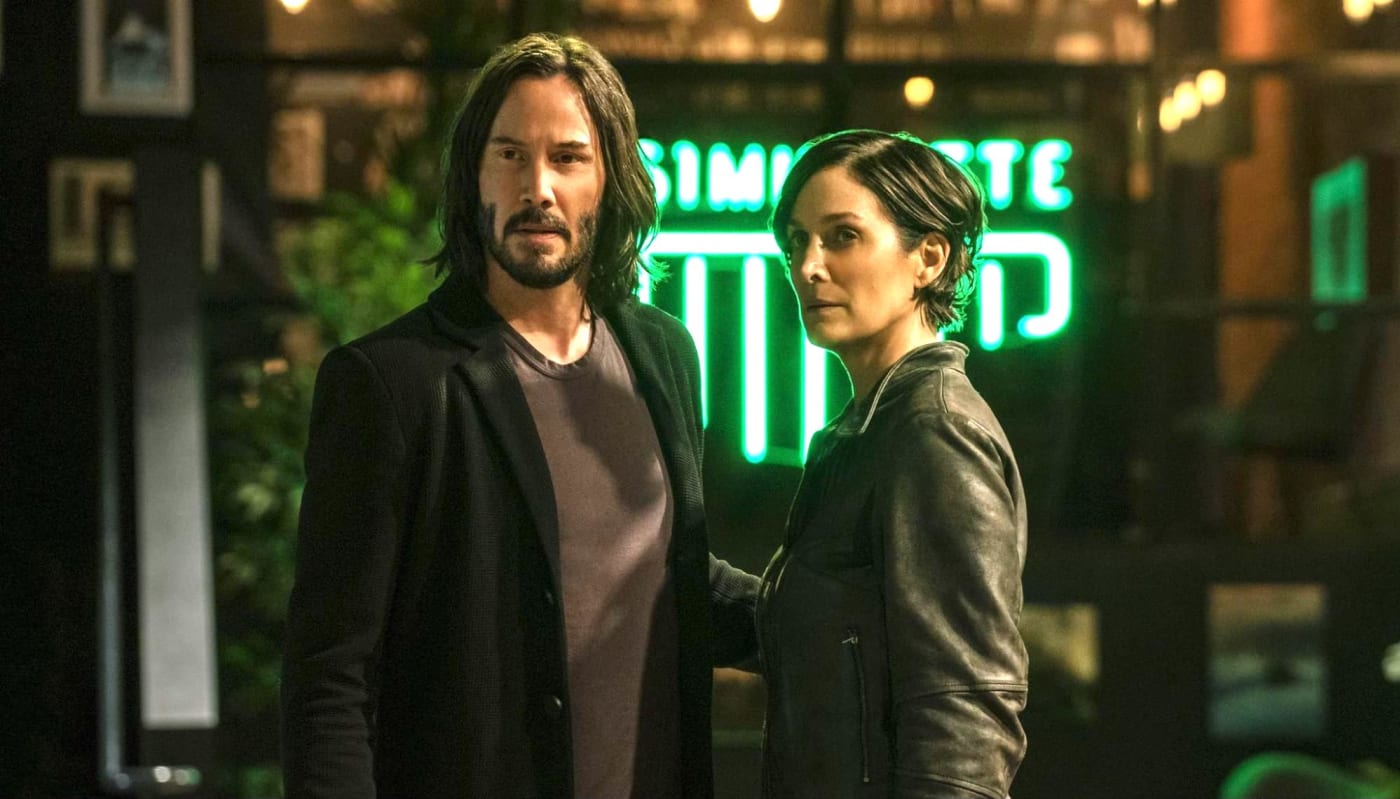It’s difficult to overstate the deep cultural impact of The Matrix. It redefined the sci-fi film genre and shaped an entire generation of fans, it raked in $460 million worldwide, garnered multiple Oscars, and sent the already healthy careers of Keanu Reeves and Laurence Fishburne (the latter being somehow recast in the new one) into true stardom. I’m a fan myself, loving the first two films and believing Reeves’ Neo to be one of my favorite sci-fi heroes of all time, and I was so happy when the Wachowskis announced the series’ fourth installment: The Matrix Resurrections. It’s not a perfect film, but there’s enough of the old magic to delight longtime fans. The stars still radiate chemistry, there are plenty of cameos and sly nods to the franchise throughout, and the familiar themes have been subtly updated to make them more relevant than ever.
The film opens with a new character named Bugs (Jessica Henwick), captain of a rebel ship called the Mnemosyne, stumbling upon an odd program running on old code in an isolated node of the Matrix. It’s running a recreation of the original film’s famous opening scene in which Trinity takes out a group of armed officers and must flee from Agents. But certain key details are all wrong—including the presence of an Agent who turns out to be the digital embodiment of “Morpheus” (Yahya Abdul-Mateen II, replacing the legendary Fishburne). Bugs frees Morpheus from the node and they team up to track down Neo in the Matrix.

Neo, back in his Thomas Anderson persona, is working at a game design company called Deus Machina, with his boss and partner Smith (Jonathan Groff). Thomas is famous for designing the company’s most successful gaming franchise: the Matrix. But he keeps having vivid dreams that seem like memories, and can’t shake a nagging sense that he really is imprisoned inside a fake computer reality. He regularly sees a therapist (Neil Patrick Harris), who keeps him well supplied with prescription blue pills. Thomas is also strangely drawn to a married mom named Tiffany (Carrie Ann Moss) who frequents the same café (aptly named Simulatté). Of course, Thomas’s beliefs turns out to be correct and he gets his “memory” back – he realizes that he is Neo, Tiffany is Trinity, Smith is Agent Smith (who is still out to kill him), and he needs to return to reality. It’s not long before Bugs and Morpheus track him down and figure out how to rescue him from the Matrix once again.
The film’s premise is ingenious: the concept of the Matrix, and Neo being the One who can control it, is so powerful that the system had to figure out how to dilute it. What better way to do so than by trivializing it – transforming the classic heroic myth into entertainment? It provides the perfect opportunity to work in clever fan-service nods to the original trilogy in some unexpected ways. And Lana Wachowski, who’s the sole director this time around, have come up with an especially cool twist to the film’s classic “bullet time” scenes that I can’t discuss in depth without spoilers. Let’s just say Neo can do more than just dodge bullets for now.
There have been some technological updates, too. Bugs and her fellow human rebels pass in and out of the Matrix using mirrors as portals rather than phone lines. Agents can now wear “skins” to blend in better with the simulated humans in the Matrix, and apparently lost their power to possess others. Morpheus can be embodied outside of the Matrix via nanobots, which were never even thought about in the original trilogy.
We see this in a Matrix – and a world – that has evolved, now being representative of contemporary culture the way the original represented 1999. In Resurrections, Deus Machina forces Neo to work on a fourth installment of a game based on the film franchise itself, giving Lana Wachowski, as director, a way to represent the studio franchise system’s obsession with focus groups and marketing. In what I can only describe as the best fourth-wall-break ever, the game they were working on was actually released as The Matrix Awakens, a game made on Unreal Engine 5 and distributed for free on Steam and Xbox Series X. As the game development team argues about which elements are most crucial, and what the true meaning of the Matrix is, it’s not hard to imagine the scenes as reflections of the director’s own frustrations when making the game (which she was behind as well) or the fourth movie.

No Matrix sequel will ever come close to the unique visuals and breathtaking originality of the first film, and Resurrections has some issues. Most notably, the entire third act is poorly paced and muddled, although it still finds its feet to bring us to a satisfying conclusion. The dialogue is often stilted, or bordering on the third Matrix‘s pretentious nature, which always a fine line to straddle when it comes to “philosophical” action movies. Jonathan Groff’s performance sticks out like a sore thumb compared to the rest of the cast, leaving me and many other viewers longing for Hugo Weaving’s return as Agent Smith (which will probably never happen…). And there is some pretty heavy-handed moralizing at times that would have benefited from a more subtle approach.
But these issues aren’t enough to take away your enjoyment of what is otherwise a very entertaining film that gives fans of the franchise what they want. It’s got striking visuals, emotional resonance, dry wit, enough conceptual and thematic depth to spark some intriguing discussion, and plenty of fight scenes with choreography as electrifying as the original films. In short, it’s a solid addition to the franchise that works more often than it doesn’t.
4/5 STARS

